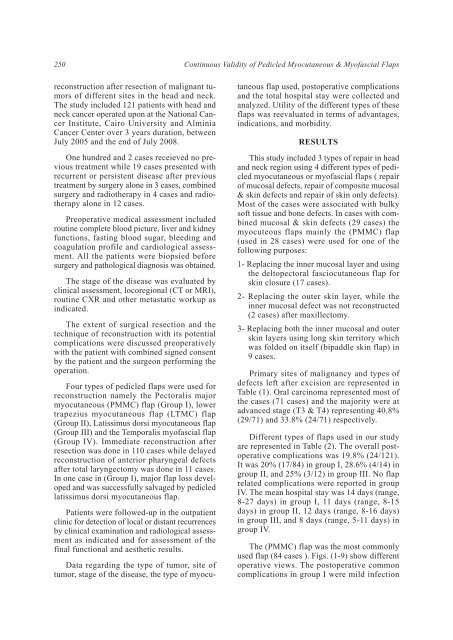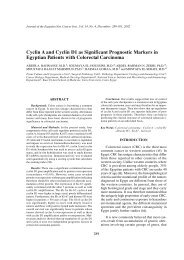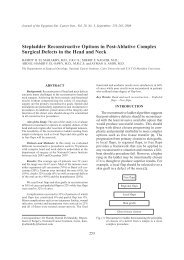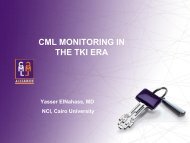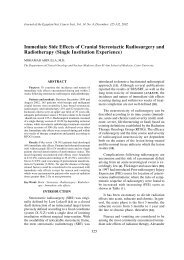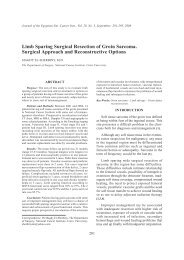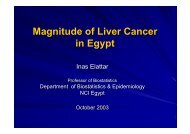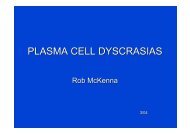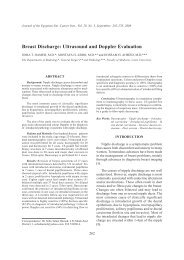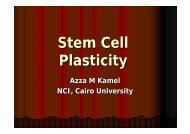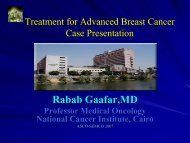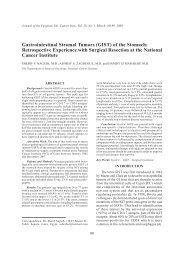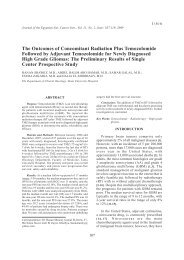Continuous Validity of Pedicled Myocutaneous and Myofascial ... - NCI
Continuous Validity of Pedicled Myocutaneous and Myofascial ... - NCI
Continuous Validity of Pedicled Myocutaneous and Myofascial ... - NCI
Create successful ePaper yourself
Turn your PDF publications into a flip-book with our unique Google optimized e-Paper software.
250<br />
<strong>Continuous</strong> <strong>Validity</strong> <strong>of</strong> <strong>Pedicled</strong> <strong>Myocutaneous</strong> & My<strong>of</strong>ascial Flaps<br />
reconstruction after resection <strong>of</strong> malignant tumors<br />
<strong>of</strong> different sites in the head <strong>and</strong> neck.<br />
The study included 121 patients with head <strong>and</strong><br />
neck cancer operated upon at the National Cancer<br />
Institute, Cairo University <strong>and</strong> Alminia<br />
Cancer Center over 3 years duration, between<br />
July 2005 <strong>and</strong> the end <strong>of</strong> July 2008.<br />
One hundred <strong>and</strong> 2 cases receieved no previous<br />
treatment while 19 cases presented with<br />
recurrent or persistent disease after previous<br />
treatment by surgery alone in 3 cases, combined<br />
surgery <strong>and</strong> radiotherapy in 4 cases <strong>and</strong> radiotherapy<br />
alone in 12 cases.<br />
Preoperative medical assessment included<br />
routine complete blood picture, liver <strong>and</strong> kidney<br />
functions, fasting blood sugar, bleeding <strong>and</strong><br />
coagulation pr<strong>of</strong>ile <strong>and</strong> cardiological assessment.<br />
All the patients were biopsied before<br />
surgery <strong>and</strong> pathological diagnosis was obtained.<br />
The stage <strong>of</strong> the disease was evaluated by<br />
clinical assessment, locoregional (CT or MRI),<br />
routine CXR <strong>and</strong> other metastatic workup as<br />
indicated.<br />
The extent <strong>of</strong> surgical resection <strong>and</strong> the<br />
technique <strong>of</strong> reconstruction with its potential<br />
complications were discussed preoperatively<br />
with the patient with combined signed consent<br />
by the patient <strong>and</strong> the surgeon performing the<br />
operation.<br />
Four types <strong>of</strong> pedicled flaps were used for<br />
reconstruction namely the Pectoralis major<br />
myocutaneous (PMMC) flap (Group I), lower<br />
trapezius myocutaneous flap (LTMC) flap<br />
(Group II), Latissimus dorsi myocutaneous flap<br />
(Group III) <strong>and</strong> the Temporalis my<strong>of</strong>ascial flap<br />
(Group IV). Immediate reconstruction after<br />
resection was done in 110 cases while delayed<br />
reconstruction <strong>of</strong> anterior pharyngeal defects<br />
after total laryngectomy was done in 11 cases.<br />
In one case in (Group I), major flap loss developed<br />
<strong>and</strong> was successfully salvaged by pedicled<br />
latissimus dorsi myocutaneous flap.<br />
Patients were followed-up in the outpatient<br />
clinic for detection <strong>of</strong> local or distant recurrences<br />
by clinical examination <strong>and</strong> radiological assessment<br />
as indicated <strong>and</strong> for assessment <strong>of</strong> the<br />
final functional <strong>and</strong> aesthetic results.<br />
Data regarding the type <strong>of</strong> tumor, site <strong>of</strong><br />
tumor, stage <strong>of</strong> the disease, the type <strong>of</strong> myocutaneous<br />
flap used, postoperative complications<br />
<strong>and</strong> the total hospital stay were collected <strong>and</strong><br />
analyzed. Utility <strong>of</strong> the different types <strong>of</strong> these<br />
flaps was reevaluated in terms <strong>of</strong> advantages,<br />
indications, <strong>and</strong> morbidity.<br />
RESULTS<br />
This study included 3 types <strong>of</strong> repair in head<br />
<strong>and</strong> neck region using 4 different types <strong>of</strong> pedicled<br />
myocutaneous or my<strong>of</strong>ascial flaps ( repair<br />
<strong>of</strong> mucosal defects, repair <strong>of</strong> composite mucosal<br />
& skin defects <strong>and</strong> repair <strong>of</strong> skin only defects).<br />
Most <strong>of</strong> the cases were associated with bulky<br />
s<strong>of</strong>t tissue <strong>and</strong> bone defects. In cases with combined<br />
mucosal & skin defects (29 cases) the<br />
myocuteous flaps mainly the (PMMC) flap<br />
(used in 28 cases) were used for one <strong>of</strong> the<br />
following purposes:<br />
1- Replacing the inner mucosal layer <strong>and</strong> using<br />
the deltopectoral fasciocutaneous flap for<br />
skin closure (17 cases).<br />
2- Replacing the outer skin layer, while the<br />
inner mucosal defect was not reconstructed<br />
(2 cases) after maxillectomy.<br />
3- Replacing both the inner mucosal <strong>and</strong> outer<br />
skin layers using long skin territory which<br />
was folded on itself (bipaddle skin flap) in<br />
9 cases.<br />
Primary sites <strong>of</strong> malignancy <strong>and</strong> types <strong>of</strong><br />
defects left after excision are represented in<br />
Table (1). Oral carcinoma represented most <strong>of</strong><br />
the cases (71 cases) <strong>and</strong> the majority were at<br />
advanced stage (T3 & T4) representing 40.8%<br />
(29/71) <strong>and</strong> 33.8% (24/71) respectively.<br />
Different types <strong>of</strong> flaps used in our study<br />
are represented in Table (2). The overall postoperative<br />
complications was 19.8% (24/121).<br />
It was 20% (17/84) in group I, 28.6% (4/14) in<br />
group II, <strong>and</strong> 25% (3/12) in group III. No flap<br />
related complications were reported in group<br />
IV. The mean hospital stay was 14 days (range,<br />
8-27 days) in group I, 11 days (range, 8-15<br />
days) in group II, 12 days (range, 8-16 days)<br />
in group III, <strong>and</strong> 8 days (range, 5-11 days) in<br />
group IV.<br />
The (PMMC) flap was the most commonly<br />
used flap (84 cases ). Figs. (1-9) show different<br />
operative views. The postoperative common<br />
complications in group I were mild infection


